Why the CMO and CIO Relationship Matters for Marketing Success With Theresa O’Neil From Zylo [AMP 250]
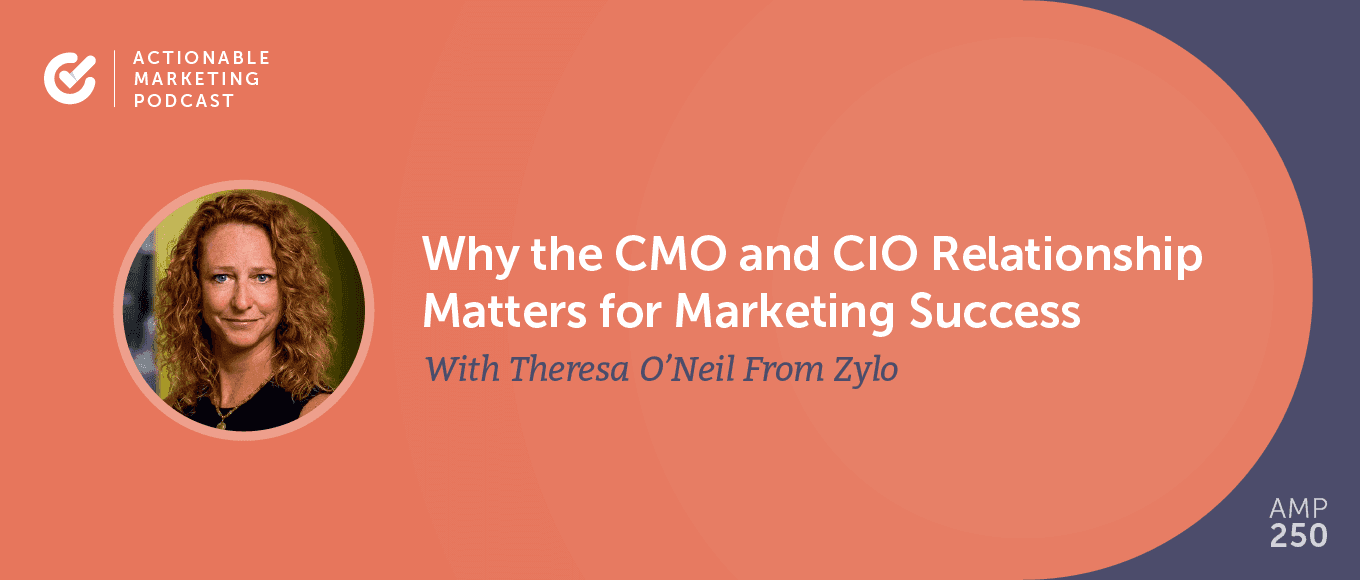 How well do most CMOs know their CIO or IT director? Not as well as they should. It’s important for marketers to build strong relationships with their technical teams to achieve marketing success.
Today’s guest is Theresa O’Neil, CMO of Zylo, a SaaS management platform. She talks about what and why CMOs and marketing leaders need to navigate side by side with IT to get the most from their technology, to make sure they're not bleeding their martech stack budget, and to ensure that they're collectively driving the most ROI possible.
Some of the highlights of the show include:
How well do most CMOs know their CIO or IT director? Not as well as they should. It’s important for marketers to build strong relationships with their technical teams to achieve marketing success.
Today’s guest is Theresa O’Neil, CMO of Zylo, a SaaS management platform. She talks about what and why CMOs and marketing leaders need to navigate side by side with IT to get the most from their technology, to make sure they're not bleeding their martech stack budget, and to ensure that they're collectively driving the most ROI possible.
Some of the highlights of the show include:
- Marketers: Use the right tools to get the right jobs done for the right people
- How many SaaS applications does the average company purchase? A lot
- How many of those SaaS applications are not actually being used? A lot
- Marketing creates pipelines so sales can close deals and generate revenue
- Win-Win: Marketing and IT team up to make people happy, effective, productive
- Shadow IT: Marketing and IT collaborate and crowdsource selected software
- Goals and Objectives: How to build a bridge between marketing and IT
- Technology is great when it works, but who fixes the problem when it doesn’t? IT
- Maintain and grow lifecycle mentality by putting technology, processes in place
- “In marketing, to do a great job, you need the right tools, and it's never been more important than it is now.”
- “The average company has over 600 SaaS applications. Most of them, IT doesn't know about.”
- “38% of licenses go unused every month. Just think about it. If you could reclaim 38% of your tech budget, for a marketer, that could absolutely be found money that you could use for a new initiative, or program, or something else that can really help you meet your goals.”
- “By partnering together and making those employees happy and productive, you're also making sure you're not wasting budget.”
Why the CMO and CIO Relationship Matters for Marketing Success With @TZONeil From @getzylo
Click To Tweet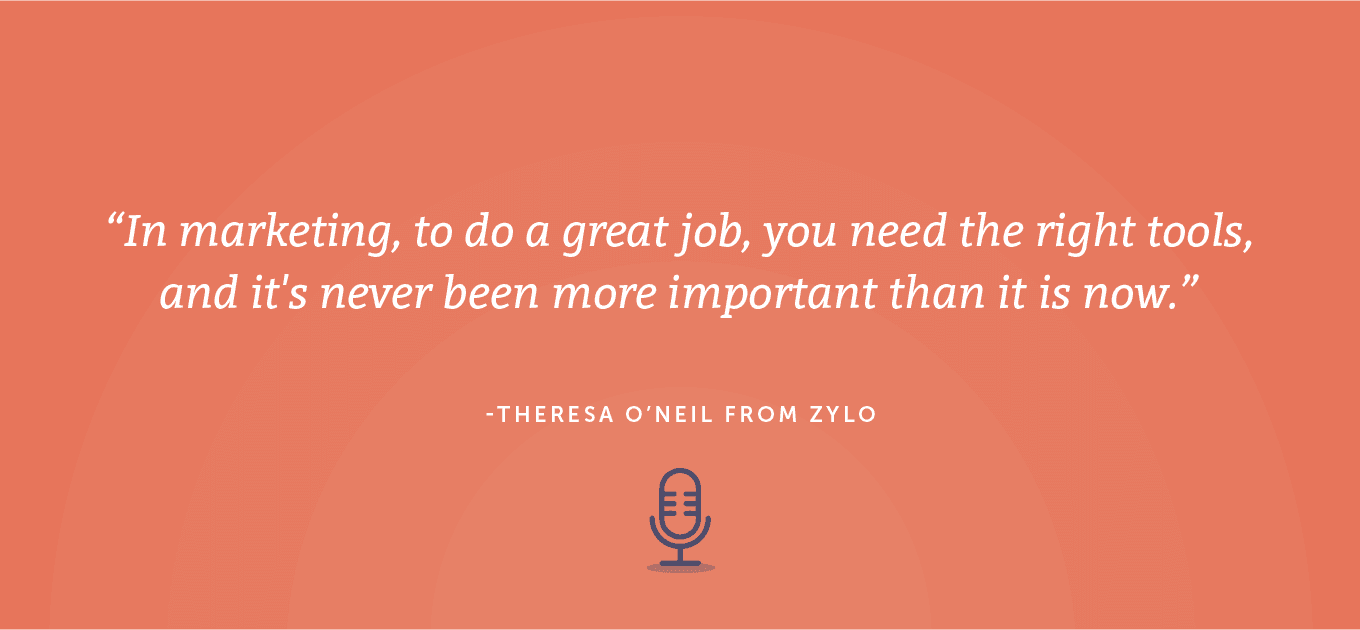 One of the reasons why it's so challenging is the talent environment that we're in with people coming and going out of the team. People will choose a tool, they'll leave, and a new person will come in.
You also have the industry consolidation. If you think about ABM (account-based marketing) all kinds of acquisition is going there. For a marketing team to have the very best tools that will allow them to reach the right audience both efficiently and effectively is key, because otherwise, you're going to be spending more of your budget on tools that you're not using.
If you don't have the right tools, you're probably going to be spending more of your program budget than you would want as well, so it's super important to have the right tools. It doesn't matter if you're with a giant company or a startup, marketing budget is always limited. You need to spend it in the best possible way.
Ben: Right. That's something that's really important to think about. All of us wish we had more budget. You might actually have "more budget" just sitting right under your nose that's just leaking off the balance sheet a little bit because it's going into tools that maybe you shouldn't be paying for.
Theresa: Yeah, absolutely. One of the things that we have found about Zylo is that people don't know how many SaaS applications they have.
I'm going to blow it beyond marketing for a moment and I'll dive back in. The average company has over 600 SaaS applications. Most of them, IT doesn't know about. Then, you take that down to marketing. Say you're a new CMO coming in. You actually don't know all the tools that you're paying for because they don't necessarily all hit the budget that you see from accounting. A lot of it is done by credit card.
One of the reasons why it's so challenging is the talent environment that we're in with people coming and going out of the team. People will choose a tool, they'll leave, and a new person will come in.
You also have the industry consolidation. If you think about ABM (account-based marketing) all kinds of acquisition is going there. For a marketing team to have the very best tools that will allow them to reach the right audience both efficiently and effectively is key, because otherwise, you're going to be spending more of your budget on tools that you're not using.
If you don't have the right tools, you're probably going to be spending more of your program budget than you would want as well, so it's super important to have the right tools. It doesn't matter if you're with a giant company or a startup, marketing budget is always limited. You need to spend it in the best possible way.
Ben: Right. That's something that's really important to think about. All of us wish we had more budget. You might actually have "more budget" just sitting right under your nose that's just leaking off the balance sheet a little bit because it's going into tools that maybe you shouldn't be paying for.
Theresa: Yeah, absolutely. One of the things that we have found about Zylo is that people don't know how many SaaS applications they have.
I'm going to blow it beyond marketing for a moment and I'll dive back in. The average company has over 600 SaaS applications. Most of them, IT doesn't know about. Then, you take that down to marketing. Say you're a new CMO coming in. You actually don't know all the tools that you're paying for because they don't necessarily all hit the budget that you see from accounting. A lot of it is done by credit card.
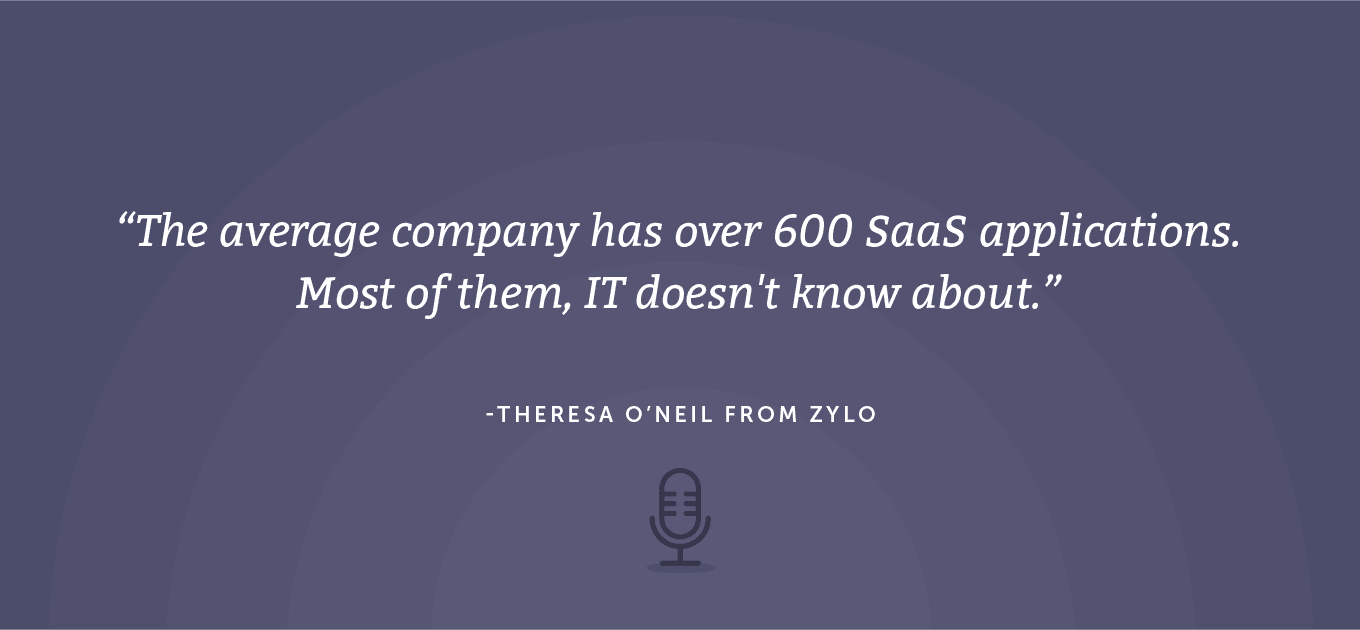 We've all done the free trial, and then your credit card gets hit the next week. For a CMO to be able to actually see all the applications that the team is using and then actually see what's being used—because that's the other thing, a lot of things aren't being used.
Typically, we find that in Zylo, 38% of licenses go unused every month. Just think about it. If you could reclaim 38% of your tech budget, for a marketer, that could absolutely be found money that you could use for a new initiative, program, or something else that can really help you meet your goals.
We've all done the free trial, and then your credit card gets hit the next week. For a CMO to be able to actually see all the applications that the team is using and then actually see what's being used—because that's the other thing, a lot of things aren't being used.
Typically, we find that in Zylo, 38% of licenses go unused every month. Just think about it. If you could reclaim 38% of your tech budget, for a marketer, that could absolutely be found money that you could use for a new initiative, program, or something else that can really help you meet your goals.
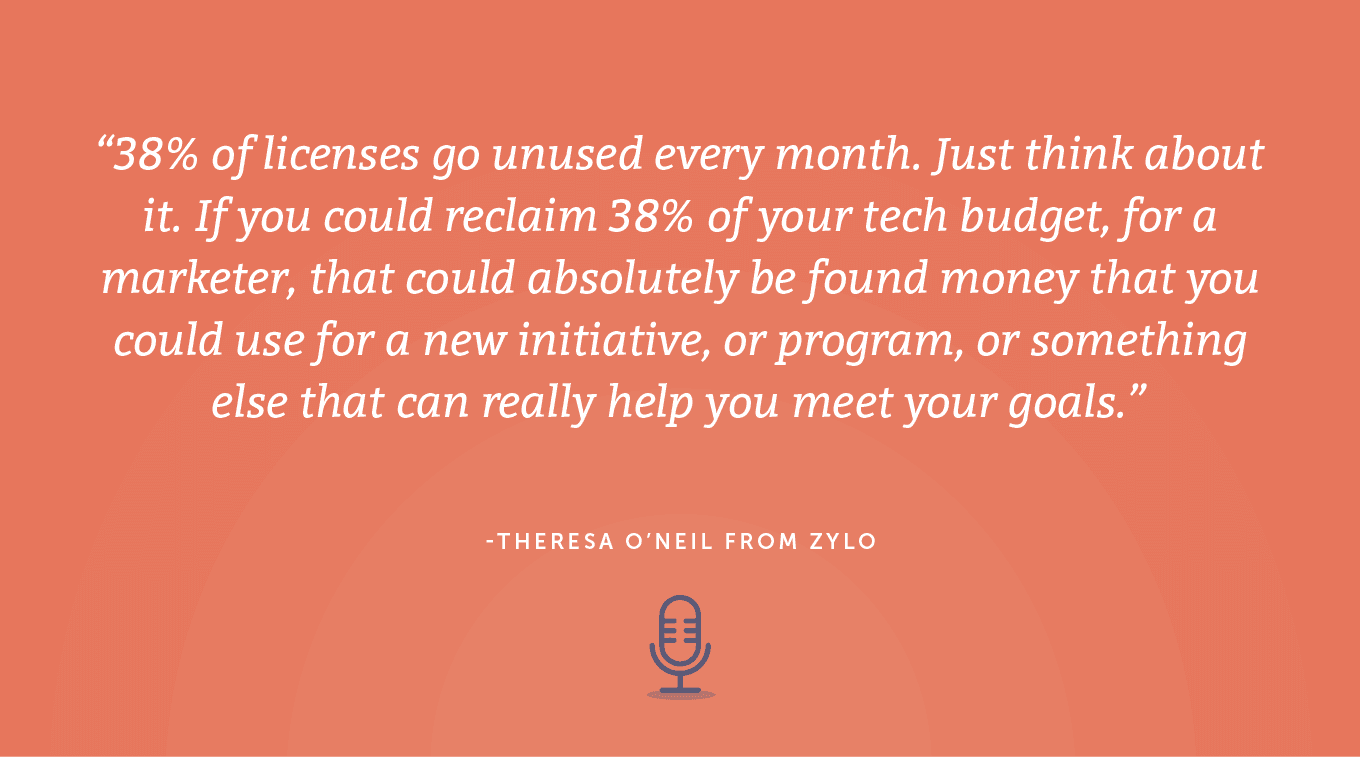 Ben: Yeah, for sure. Can you give me your brief explanation or almost your elevator pitch, if you will, for why it's so important for the CMO, the CIO, or whatever the equivalent of those job titles is in your organization—the marketing director, the head IT person, or whoever that might be—to have a really tight working relationship as it pertains to the technology that the marketing team is using?
Theresa: If I'm going to give you my elevator pitch for why basically marketing and IT need to work closely together, it comes down to making sure that the marketing team has the right tools to do a great job for the company because marketing is about creating pipelines so that sales can close deals. That's revenue back into the company.
For IT, IT wants to ensure governance, whatever the policies are within your organization. By teaming together, they can make sure that both of those goals are met. A project management tool that's right for marketing sometimes isn't right for engineering, but by working with IT, they can make sure that they meet those needs without having redundant tools. It's a way really to meet the overall objectives of the organization.
Ben: I think that's a great way to sum it up. A scenario that is pretty common and that you had touched on really briefly is you have a company with an incoming CMO. I believe that the statistic for an average tenure of a CMO is 24 months, 25 months. It's a little over two years. This is the situation that crops up surprisingly often, that you have a new head of the department who is adopting whatever technology stack is already existing with that company.
If a new CMO ignores the CIO or the IT Director, or if they don't outright ignore them, but they don't really make a proactive effort of any kind to build a bridge with that team and get a sense of what's at their disposal right away, what are some of the downsides or the challenges that they might end up facing shortly thereafter as a result of not knowing either what they have at their disposal, what they're burning money on, what have you?
Theresa: There are a lot of downsides of not partnering as a marketing leader with your IT leader. It comes down to having the wrong tools. If you have the wrong tools, you're not only going to be inefficient. You're going to have unhappy employees. Again, marketing being so tech-heavy and really for all of us in this new hybrid world, SaaS is the workplace.
We're doing this podcast over Zoom. Everything we do to collaborate now is through technology. If you have the wrong tools, you're going to have unhappy employees. More and more CIOs—when we talk to our CIO advisory council in Zylo—are telling us they are being tasked with employee effectiveness.
By partnering together and making those employees happy and productive, you're also making sure you're not wasting budget either on technology that you're not using, or if you're using technology that's not a great fit, you might not be getting the ROI that you depend on for marketing. It's really a win-win for marketing and IT to work closely together.
Ben: Yeah, for sure. Can you give me your brief explanation or almost your elevator pitch, if you will, for why it's so important for the CMO, the CIO, or whatever the equivalent of those job titles is in your organization—the marketing director, the head IT person, or whoever that might be—to have a really tight working relationship as it pertains to the technology that the marketing team is using?
Theresa: If I'm going to give you my elevator pitch for why basically marketing and IT need to work closely together, it comes down to making sure that the marketing team has the right tools to do a great job for the company because marketing is about creating pipelines so that sales can close deals. That's revenue back into the company.
For IT, IT wants to ensure governance, whatever the policies are within your organization. By teaming together, they can make sure that both of those goals are met. A project management tool that's right for marketing sometimes isn't right for engineering, but by working with IT, they can make sure that they meet those needs without having redundant tools. It's a way really to meet the overall objectives of the organization.
Ben: I think that's a great way to sum it up. A scenario that is pretty common and that you had touched on really briefly is you have a company with an incoming CMO. I believe that the statistic for an average tenure of a CMO is 24 months, 25 months. It's a little over two years. This is the situation that crops up surprisingly often, that you have a new head of the department who is adopting whatever technology stack is already existing with that company.
If a new CMO ignores the CIO or the IT Director, or if they don't outright ignore them, but they don't really make a proactive effort of any kind to build a bridge with that team and get a sense of what's at their disposal right away, what are some of the downsides or the challenges that they might end up facing shortly thereafter as a result of not knowing either what they have at their disposal, what they're burning money on, what have you?
Theresa: There are a lot of downsides of not partnering as a marketing leader with your IT leader. It comes down to having the wrong tools. If you have the wrong tools, you're not only going to be inefficient. You're going to have unhappy employees. Again, marketing being so tech-heavy and really for all of us in this new hybrid world, SaaS is the workplace.
We're doing this podcast over Zoom. Everything we do to collaborate now is through technology. If you have the wrong tools, you're going to have unhappy employees. More and more CIOs—when we talk to our CIO advisory council in Zylo—are telling us they are being tasked with employee effectiveness.
By partnering together and making those employees happy and productive, you're also making sure you're not wasting budget either on technology that you're not using, or if you're using technology that's not a great fit, you might not be getting the ROI that you depend on for marketing. It's really a win-win for marketing and IT to work closely together.
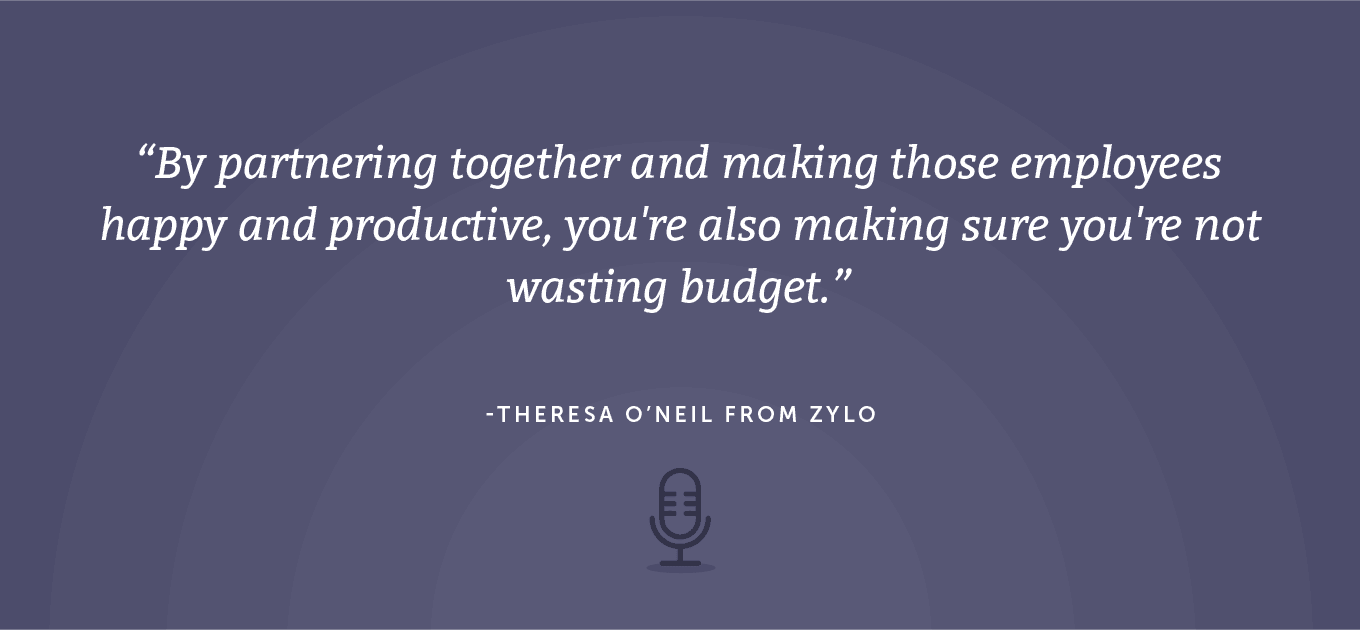 Ben: Yeah. The three letters ROI really hold a lot of weight with marketers, or at least they should. If nothing else drives the point home, maybe that will.
Conversely, what are some of the real potential benefits or upsides that maybe aren't so obvious but are there for marketers who are proactive about collaborating with IT in making sure that the marketing team can get what they need and that the IT team is happy because they're not wasting money, they're not maintaining things that are difficult, or whatever the case may be?
Theresa: There are some really great benefits and upsides for marketing and IT to work together. I'm going to share an example that one of our Zylo's customers, Coupa, shared with us in a webinar about a week ago.
One of the things that they wanted to do is shine a light into shadow IT. Shadow IT are all the applications that it may not be aware of. They found that the marketing team was using a project management tool that they weren't aware of. They went through their process to vet it, made sure it met all of their compliance roles, and found out that it was a great tool. It was really helping the team be productive. Then, they begin to actually offer that tool out to the rest of the organization.
IT having that visibility is not about control or taking away tools, it's about making sure that they're following their rules of governance. Then, they can start to negotiate that more from an enterprise point of view, get a better per-license cost for everyone, and then now, you got another great tool that is ready for the organization.
By collaborating, they're actually able to almost crowdsource the selection of software by seeing what people are actually using. It's a win for marketing and IT because it brings down costs and it brings great tools, not just to the marketing team but potentially to the whole company.
Ben: An underlying and recurring theme in this conversation is the importance of understanding the human element inherent to bridging the gap between marketing and IT.
It's easy sometimes to think of your CIO or your technical staff as the folks that you contact when something breaks or when something goes wrong. But if that's the only time you talk to someone on that side of your organization, then it's likely you're going to have a strained or a contentious relationship with those folks that isn't really as productive as what it should be for either side. It's important to remember that a little bit of empathy can go a long way.
Now, back to Theresa.
Let's meet a hypothetical listener where they're at right now. Let's say that this hypothetical listener doesn't really have much of a connection with their IT team right now or probably not anything beyond the bare minimum. I think you'd have a hard time never talking to IT, but let's say that talking to IT is something they avoid. It's a conversation they dread a little bit just because those two worlds are very different and tend to attract very different people, very different communication styles, and different ways of working. All kinds of reasons that are not great, but lots of reasons that exist for why the marketing team and the IT team may butt heads.
How would you recommend a CMO in that situation to begin building that bridge with their IT team, with their CIO, or with whoever it is who's responsible for making technology decisions in their organization?
Theresa: The question of how marketing can build a bridge to IT is an especially challenging one in these times when your usual collaboration with each other might be the one-hour exec team meeting that you're both on.
In ordinary times, I'd say go out for a beverage. That would be the best way to connect. In these times, you have to pause and think about what are their goals? What are their objectives that they're being measured on?
For many CIOs right now, as I mentioned, it's about employee effectiveness, governance, security, and different compliance and regulations that they have to meet, starting with what are they trying to do in their job and how can we work together?
At Zylo, I'm not just head of marketing. I am part of the first team. I'm trying to do what's best for the whole company. You can really use empathy, align with what their objectives are, work together to do that, and just show some understanding because like marketing, they have tight deadlines. They are delivering the applications and technologies to make the whole company successful.
That's where I would start. Then, fingers crossed that you can have that beverage some time in the near future.
Ben: That is such a great answer because a lot of it really does hinge on empathy. It is very easy for us as marketers to think about our teams getting what we want and treating things like a winning and losing mindset rather than a collaborative one where you're thinking about okay, how can both of our sides work together so we both achieve our goals?
That's a great point because the marketing team isn't going to know what the IT team's problems are and what their situation is like, but they're under a lot of stress.
Theresa: Right. We were joking when you were getting all the technology to work for this that technology is great when it works. When we have a problem, we don't hesitate to reach out to IT, they help us, and then we go back to our thoughts.
Use that empathy to think about how this team is doing that all day long for everyone in the company. They're trying to select the best tools. How can we work with them to help them do their jobs? I think that's a great starting point to build any relationship.
Ben: Yeah, certainly. It's maybe a useful mental exercise to just imagine how it feels to take people's complaints all day.
Theresa: Yeah, not for me. Thank you.
Ben: Yeah. Me neither. At a certain point, I'd just be like, I don't know, figure it out. Turn it off and turn it back on again.
Theresa: That's my strategy.
Ben: It works 90% of the time.
Theresa: It totally works.
Ben: Once a CMO and CIO have had a beer or another beverage of their choice—maybe alcoholic, perhaps none—let's say that happened. They're starting to work together. They have a bit of a warmer relationship than they did in the past. They both understand what one another needs from the other side. What are some non-obvious or easy-to-overlook things at that point that they should be mindful of to ensure that that relationship stays productive?
Because like we're saying, marketing and IT, these two worlds are a mystery to one another in a lot of ways. What are some other things that the CMO should be mindful of to make sure that they really are a productive, collaborative partner with their CIO?
Theresa: It's really interesting when you ask what should the CMO be thinking about to maintain and really grow this relationship with the CIO. Again, since we're focusing on technology, I think the shared capacity or focus of the CIO and marketing are very different personalities. But underneath it all, we're both really about technology and we both love it even though we're going to talk about it in completely different ways.
One of the great starting points is acknowledging the importance of the technology—for marketing, those are SaaS applications—and begin to talk about what a SaaS management lifecycle looks like because this is not once-and-done.
Going back to the beginning of our conversation when we talked about the talent squeeze right now, the average tenure of a CMO, and industry consolidation, the average organization has 10 new SaaS applications a week and 4 leaving. This is constant. It's something that you have to stay on top of.
How do you collaborate to say how are we going to maintain this to make sure that we have a vetting process that we both agree on and that we have visibility? How are we going to keep an eye on who's actually using licenses? How do we want to proactively manage our renewals? If we have a procurement department, how do we give them the data they need so they can really go into negotiations empowered with usage information?
If you start to build that collaboration with the CIO and IT, you might bring in procurement and finance, but how do you work together to create this lifecycle where you're discovering all of your SaaS, you're optimizing how you're using it, you're planning how you're going to do your renewals going forward, and then you're ensuring governance?
Having an idea of what that lifecycle looks like so that this great state that you're in at this moment is maintained and optimized going forward because if you treat it as once-and-done, in six months, you'll just be back in the hole. The other thing they can do is just have that lifecycle mentality and put the technology and the processes in place to make sure that you're optimizing that going forward.
Ben: That's a great answer. I love the way you frame it as a relationship and not a one-off thing. You don't go wine and dine your IT director.
Theresa: Yeah. You say to him or her, I care about your compliance goal. Maybe we need a SaaS management platform—ideally Zylo, I'm not going to lie—but how do we put that in place so that I can help you meet your goal?
Ben: Absolutely. Theresa, that's all I have for you, but this is a fantastic conversation. Thanks so much for coming on the show.
If people want to find you or Zylo on the web, where would you point them toward?
Theresa. You can find us at zylo.com, and you can find me on LinkedIn.
Ben: Yeah. The three letters ROI really hold a lot of weight with marketers, or at least they should. If nothing else drives the point home, maybe that will.
Conversely, what are some of the real potential benefits or upsides that maybe aren't so obvious but are there for marketers who are proactive about collaborating with IT in making sure that the marketing team can get what they need and that the IT team is happy because they're not wasting money, they're not maintaining things that are difficult, or whatever the case may be?
Theresa: There are some really great benefits and upsides for marketing and IT to work together. I'm going to share an example that one of our Zylo's customers, Coupa, shared with us in a webinar about a week ago.
One of the things that they wanted to do is shine a light into shadow IT. Shadow IT are all the applications that it may not be aware of. They found that the marketing team was using a project management tool that they weren't aware of. They went through their process to vet it, made sure it met all of their compliance roles, and found out that it was a great tool. It was really helping the team be productive. Then, they begin to actually offer that tool out to the rest of the organization.
IT having that visibility is not about control or taking away tools, it's about making sure that they're following their rules of governance. Then, they can start to negotiate that more from an enterprise point of view, get a better per-license cost for everyone, and then now, you got another great tool that is ready for the organization.
By collaborating, they're actually able to almost crowdsource the selection of software by seeing what people are actually using. It's a win for marketing and IT because it brings down costs and it brings great tools, not just to the marketing team but potentially to the whole company.
Ben: An underlying and recurring theme in this conversation is the importance of understanding the human element inherent to bridging the gap between marketing and IT.
It's easy sometimes to think of your CIO or your technical staff as the folks that you contact when something breaks or when something goes wrong. But if that's the only time you talk to someone on that side of your organization, then it's likely you're going to have a strained or a contentious relationship with those folks that isn't really as productive as what it should be for either side. It's important to remember that a little bit of empathy can go a long way.
Now, back to Theresa.
Let's meet a hypothetical listener where they're at right now. Let's say that this hypothetical listener doesn't really have much of a connection with their IT team right now or probably not anything beyond the bare minimum. I think you'd have a hard time never talking to IT, but let's say that talking to IT is something they avoid. It's a conversation they dread a little bit just because those two worlds are very different and tend to attract very different people, very different communication styles, and different ways of working. All kinds of reasons that are not great, but lots of reasons that exist for why the marketing team and the IT team may butt heads.
How would you recommend a CMO in that situation to begin building that bridge with their IT team, with their CIO, or with whoever it is who's responsible for making technology decisions in their organization?
Theresa: The question of how marketing can build a bridge to IT is an especially challenging one in these times when your usual collaboration with each other might be the one-hour exec team meeting that you're both on.
In ordinary times, I'd say go out for a beverage. That would be the best way to connect. In these times, you have to pause and think about what are their goals? What are their objectives that they're being measured on?
For many CIOs right now, as I mentioned, it's about employee effectiveness, governance, security, and different compliance and regulations that they have to meet, starting with what are they trying to do in their job and how can we work together?
At Zylo, I'm not just head of marketing. I am part of the first team. I'm trying to do what's best for the whole company. You can really use empathy, align with what their objectives are, work together to do that, and just show some understanding because like marketing, they have tight deadlines. They are delivering the applications and technologies to make the whole company successful.
That's where I would start. Then, fingers crossed that you can have that beverage some time in the near future.
Ben: That is such a great answer because a lot of it really does hinge on empathy. It is very easy for us as marketers to think about our teams getting what we want and treating things like a winning and losing mindset rather than a collaborative one where you're thinking about okay, how can both of our sides work together so we both achieve our goals?
That's a great point because the marketing team isn't going to know what the IT team's problems are and what their situation is like, but they're under a lot of stress.
Theresa: Right. We were joking when you were getting all the technology to work for this that technology is great when it works. When we have a problem, we don't hesitate to reach out to IT, they help us, and then we go back to our thoughts.
Use that empathy to think about how this team is doing that all day long for everyone in the company. They're trying to select the best tools. How can we work with them to help them do their jobs? I think that's a great starting point to build any relationship.
Ben: Yeah, certainly. It's maybe a useful mental exercise to just imagine how it feels to take people's complaints all day.
Theresa: Yeah, not for me. Thank you.
Ben: Yeah. Me neither. At a certain point, I'd just be like, I don't know, figure it out. Turn it off and turn it back on again.
Theresa: That's my strategy.
Ben: It works 90% of the time.
Theresa: It totally works.
Ben: Once a CMO and CIO have had a beer or another beverage of their choice—maybe alcoholic, perhaps none—let's say that happened. They're starting to work together. They have a bit of a warmer relationship than they did in the past. They both understand what one another needs from the other side. What are some non-obvious or easy-to-overlook things at that point that they should be mindful of to ensure that that relationship stays productive?
Because like we're saying, marketing and IT, these two worlds are a mystery to one another in a lot of ways. What are some other things that the CMO should be mindful of to make sure that they really are a productive, collaborative partner with their CIO?
Theresa: It's really interesting when you ask what should the CMO be thinking about to maintain and really grow this relationship with the CIO. Again, since we're focusing on technology, I think the shared capacity or focus of the CIO and marketing are very different personalities. But underneath it all, we're both really about technology and we both love it even though we're going to talk about it in completely different ways.
One of the great starting points is acknowledging the importance of the technology—for marketing, those are SaaS applications—and begin to talk about what a SaaS management lifecycle looks like because this is not once-and-done.
Going back to the beginning of our conversation when we talked about the talent squeeze right now, the average tenure of a CMO, and industry consolidation, the average organization has 10 new SaaS applications a week and 4 leaving. This is constant. It's something that you have to stay on top of.
How do you collaborate to say how are we going to maintain this to make sure that we have a vetting process that we both agree on and that we have visibility? How are we going to keep an eye on who's actually using licenses? How do we want to proactively manage our renewals? If we have a procurement department, how do we give them the data they need so they can really go into negotiations empowered with usage information?
If you start to build that collaboration with the CIO and IT, you might bring in procurement and finance, but how do you work together to create this lifecycle where you're discovering all of your SaaS, you're optimizing how you're using it, you're planning how you're going to do your renewals going forward, and then you're ensuring governance?
Having an idea of what that lifecycle looks like so that this great state that you're in at this moment is maintained and optimized going forward because if you treat it as once-and-done, in six months, you'll just be back in the hole. The other thing they can do is just have that lifecycle mentality and put the technology and the processes in place to make sure that you're optimizing that going forward.
Ben: That's a great answer. I love the way you frame it as a relationship and not a one-off thing. You don't go wine and dine your IT director.
Theresa: Yeah. You say to him or her, I care about your compliance goal. Maybe we need a SaaS management platform—ideally Zylo, I'm not going to lie—but how do we put that in place so that I can help you meet your goal?
Ben: Absolutely. Theresa, that's all I have for you, but this is a fantastic conversation. Thanks so much for coming on the show.
If people want to find you or Zylo on the web, where would you point them toward?
Theresa. You can find us at zylo.com, and you can find me on LinkedIn.




